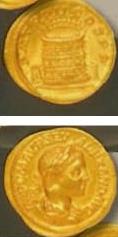Gold Aureus, View of Coliseum.
Ira and Larry Goldberg Coins and Collectibles.
Obverse- IMP C M AVR SEV ALEXAND AVG Laureate and draped bust of Severus Alexander to right.
Reverse- P M TR P II COS P P View of the Colosseum (the Flavian Amphitheatre)- the buiding has for stories, the first three of arcades each containing a statue, and the top being of solid masonry with windows and supports for the wooden masts on which great awnings were held to protect the spectators from the sun; on the left is a shrine containing a stature (perhaps of Fortuna), and on the right a pedimental building, perhaps the Temple of Jupiter Victor.
One of two known examples.
This exceptionally important piece was one of two that came from a small hoard of aurei found in the early 1960s- the other was first sold in Hess-Leu 24 and now resides in a private Swiss collection. The Colosseum, or the Amphitheatrum Flavium to give it its correct ancient name (the name Colosseum first began to be used for the building around the year 1000), was struck by lighting in 217 and was severely damaged (this was seen as a bad omen for Macrinus), Elagabalus began the repair work, which was continued by Severus Alexander, and by 223 the building was sufficiently restored to enable it to be used (work continued into the reign of Gordian III when its completion was celebrated by an issue of medallions). Severus Alexander struck a very small commemorative issue of coins in honor of the Colosseum’s reopening- a number of sestertii and asses are known, a denarius was recorded by Cohen (though it is now lost) and there are only two aurei, including the one here.
Severus Alexander reigned over the Roman Empire from 222-235 CE. He spent most of his reign at war and was killed by Roman soldiers who objected to his attempts to make peace with the Germans.
